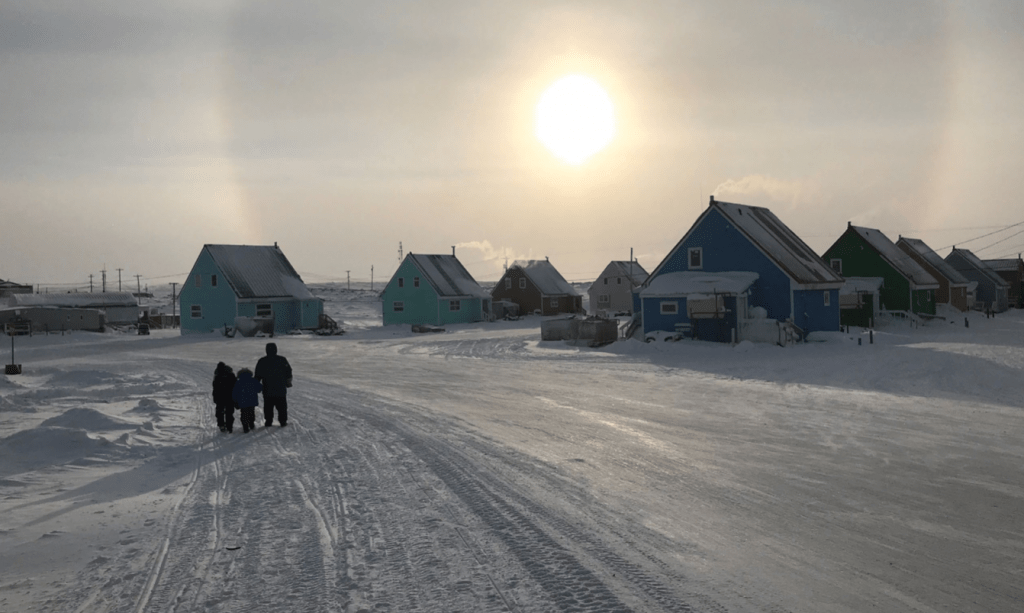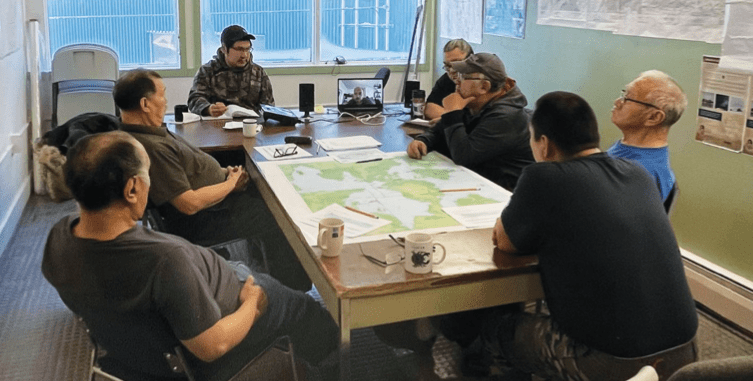Creating a New Arctic Food Economy, for Generations to Come

The Arctic Inspiration Prize, often referred to as the “Nobel of the North”, was established in 2012 to recognize potentially transformative, ideas-to-impact projects in the fields of education, health, social-cultural issues, the environment, and the economy. One 2020 AIP recipient is the Niqihaqut food sovereignty project, which aims to eliminate food insecurity caused by poverty, climate change and cultural loss. The Rideau Hall Foundation proudly serves as the managing partner for the AIP.
Jimmy Oleekatalik
In Taloyoak, the most northerly community on the North American mainland, we have always been going on the land. We are not farmers, but the land is where our food comes from. From here, on the southwestern coast of Aviqtuuq, which was briefly renamed Boothia Peninsula, there are only islands. All migrating wildlife has to pass through Taloyoak (formerly Spence Bay), by water or by land, so as soon as it starts to warm up, we go out fishing and hunting.
In the past 50 years, we’ve gone from using dog teams to using iPhones. It’s a big change. But the environment is changing, too, and it is affecting our food security. Now, after being awarded $451,000 for the Arctic Inspiration Prize (AIP)—which funds innovative projects by Northerners to improve their communities—we have money to support our plan to turn things around.
Our community of about 1,100 Inuit is located right in the migratory route of the Ahiak caribou herd, who come every summer to their calving ground in Aviqtuuq. But it is not only caribou—many species have offspring up here: seals, muskox, birds, and fish like char and cod. We also heard from a hunter who witnessed a bowhead whale calving this summer, which makes it even more special.
Yet despite our abundant wildlife—and our rich history and traditions based on hunting and gathering—many residents of Taloyoak face food insecurity. They cannot access country food, only expensive store food flown in from the south, because food from the land is under threat from climate change and from mining exploration.
The warming climate is impacting our water, our land, our sea, and now our culture and what we eat. As never before, it is getting harder to go out hunting here in Taloyoak. I’m the manager of the Spence Bay Hunter and Trapper Association (HTA) and every day we talk about how much it costs to go out hunting. Climate change is also threatening our hunters’ safety as the land, lakes, and ice become more dangerous to travel on, and the wildlife becomes more scarce and remote.
Country foods are the healthiest for us—caribou, fish, seal. We simply catch and eat it fresh, and it has no additives in it. It is the reason why we are here. It’s a big deal here, for Elders and for youth too. But a lot of Elders, single parents, and very low-income families cannot afford store food, and neither can they access country food.
For many years now it’s been talked about getting back to the basics of livelihood and diet. So, to keep our tradition alive we came up with Niqihaqut, which means “our food” in Inuktitut. But how were we going to start it? Where were we going to get the funds?
The Arctic Inspiration Prize was mentioned, so we went for it with high hopes, and we are so thankful to be able to be recognized and to be believed. We’re still dreaming, we can’t believe we won! Maybe it’s because it is an inspirational project for all? It is simply people helping people.
Our community’s priority is to adapt to climate change by developing new ways to improve country food access for all, especially low-income families, while supporting our hunters. We also have to monitor the land and the environment so that the wildlife is in good health. Niqihaqut will create a country food-based economy from a sustainable and respectful harvest and a modern cut-and-wrap facility to prepare and distribute this food throughout Taloyoak.
Niqihaqut will not only improve our people’s health and well-being, it will also help lay the groundwork by informing a management plan for our proposed Aviqtuuq Inuit Protected and Conserved Area (IPCA), which would cover 40,730 square kilometres of ocean, 4,413 square kilometres of freshwater, 20,532 kilometres of rivers and 45,039 square kilometres of land.
And it will put Inuit in charge of managing it.
An IPCA is not like a regular protected area because it puts Indigenous people in control of stewarding our traditional territories, ensuring our food security with a sustainable harvest as well as economic development like small-scale fisheries, outfitting camps, and tourism.
Aviqtuuq is our home, our traditional lands. It has provided us with what we have needed to survive and thrive here for generations. We want to see the lands and resources here protected from industrial development because the area is sacred to us, and has everything we need to prosper.
Since my grandfather’s era, when there was talk of building a pipeline across Aviqtuuq, we’ve fought to keep it safe. Nothing was happening to ensure conservation, so around 2016 we reached out to World Wildlife Fund-Canada, and that got the ball rolling. Our Spence Bay HTA was awarded over $585,000 from the Canada Nature Fund in 2019 thanks to an application that WWF-Canada helped us develop to support our vision for Aviqtuuq. Then, last year, they again supported our Arctic Inspiration Prize submission.
I was the lead on this project, alongside our team members Paul Okalik and Brandon Laforest (WWF-Canada), Tad Talurialik (youth representative), Kublu Tucktoo (retired teacher), Joe Ashevak (Spence Bay HTA chair), Lindsay Anaija (Hamlet of Taloyoak) and Vincent L’Hérault (ARCTIConnexion).
The reason these IPCA protections are needed is because warming temperatures are not the only threat from climate change. The loss of ice in the nearby Northwest Passage will also bring shipping traffic and the danger of vessels striking whales or, even worse, oil spills that we are not equipped to clean up.

And the peninsula is also coveted by the mining industry, which has exploration claims over our land, and we are very concerned about what this could bring to our future, to our food. They promise prosperity, but it comes with a cost to our social and cultural traditions, and to our environment. Aviqtuuq is the most crucial caribou habitat during calving and post-calving, but everything is going to be affected if we have a mine. From muskox and insects to polar bears and plankton, it’s one ecosystem to us.
We see what is happening in Pond Inlet with the Baffinland mine at Mary River and how it’s impacting their narwhal and caribou. We even organized a solidarity protest in Taloyoak to support the hunters because we, too, have a different vision. We’re trying to protect Aviqtuuq from industrial development, which could devastate the caribou population, but we need some kind of alternative income.
These projects will feed more families, create jobs, reduce poverty in the community and provide more money for social programs to support Elders, youth, and single parents, while keeping our culture and traditions alive for generations to come. It’s going to benefit the whole town.
A mine might create jobs for 20 years. But a new food economy and the first-ever Inuit Protected and Conserved Area in Canada would generate jobs forever, from generation to generation, and still protect the land.
This land is very beautiful, it’s our home, and it is common sense to protect it and our way of life.
Jimmy Oleekatalik is manager of the Spence Bay Hunter & Trapper Association in Taloyoak, Nunavut.
